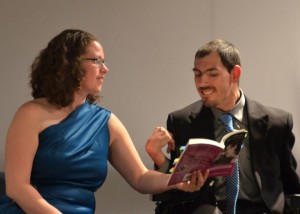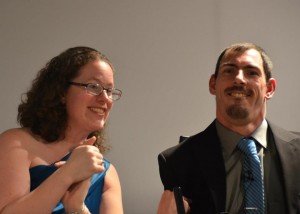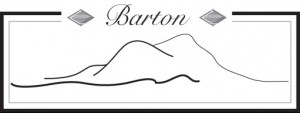Recently, one of our Facebook friends asked us a fabulous question about our public speaking and how we navigate Barton’s thick accent from Cerebral Palsy. We felt our response deserved more than a simple reply and thought her question would be an excellent topic to explore deeper.
First of all, I love this question, so I really want to thank our friend for asking it! There are a whole plethora of layers that I want to dive into here. So, bear with me, it may take a while.
 As some of you may know, Megan and I have been speaking or teaching publically for most of our marriage in some fashion or another, and over the years, the way we do this has evolved through several iterations. There are times when I can be hard to understand, particularly, if it’s the first time we meet, or if I’m excited. For a long time, before Megan and I met, I worked extremely hard to find ways to make myself more understandable. I used a lot of relaxation exercises and breathing techniques to calm myself so that the muscles in my mouth and throat could function better.
As some of you may know, Megan and I have been speaking or teaching publically for most of our marriage in some fashion or another, and over the years, the way we do this has evolved through several iterations. There are times when I can be hard to understand, particularly, if it’s the first time we meet, or if I’m excited. For a long time, before Megan and I met, I worked extremely hard to find ways to make myself more understandable. I used a lot of relaxation exercises and breathing techniques to calm myself so that the muscles in my mouth and throat could function better.
I also became very comfortable and enthusiastic about encouraging others to ask me to repeat myself. I am still happy to say something a hundred times if it allows someone to understand what I’m saying. Of course, when we speak publically, however, this isn’t a realistic option.
For the first several years, I asked Megan to repeat every word I said, and as someone with a deep love for the specificity of language, I wanted her to interpret my word choice verbatim. Of course, when I get on a roll, I tend to go so fast and so far that there was no possible way for her to keep pace, never mind get every word exact. No matter how much I tried to slow down for her benefit, I would inevitably speed up as the conversation went on.
After a while, Megan and I began to explore other ways to facilitate my voice being heard. The first step for me was letting go of my need for precision and allowing her instead to interpret the concept that I was trying to convey in her own words. This worked fairly well to a point.
Over time, we began to notice that those that we were addressing automatically began to look to her for understanding rather than even attempt direct communication. To us, this eventually caused a shift in energy as the line of communication was forced to pass through Megan rather than going directly from me to another person.
 We began to explore this and ways to correct that flow so that it once again became direct and equally meaningful. One of the most important points and feedback that we continually receive is how expressive my face and body are, regardless of how understandable the words are. This gave us an idea. We asked ourselves what would happen if we invited others to listen to our talk from a different place. Rather than trying to grasp every word, we ask people to see if they can pick up on my intent and underlying meaning regardless of how understandable my words were to their minds.
We began to explore this and ways to correct that flow so that it once again became direct and equally meaningful. One of the most important points and feedback that we continually receive is how expressive my face and body are, regardless of how understandable the words are. This gave us an idea. We asked ourselves what would happen if we invited others to listen to our talk from a different place. Rather than trying to grasp every word, we ask people to see if they can pick up on my intent and underlying meaning regardless of how understandable my words were to their minds.
Here’s what happened this first time we did this.
We also played with having a printed script, but found the magic of our speaking happens in the spontaneity of the moment. Now that we are reading from Ink in the Wheels: Stories to Make Love Roll, we will have copies of our passages available to audience members, but we will still speak off the cuff, playing off of each other, to keep the magic alive.
For the most part, this has served us well, and seems to have a lasting impact on our audiences. Sure, there are still times when I ask Megan to repeat for me, particularly in certain situations when I’m trying to get something very particular across or if it is clear to both of us that the audience is totally lost. But by and large, when we look into the eyes of our audience members, we are usually met with sparkling eyes that glow of understanding.
Stay tuned for Megan’s perspective…

